85 F. high temperature in St. Cloud Saturday.
82 F. average high on August 1.
89 F. high on August 1, 2014.
August 2, 1831: Cold outbreak across Minnesota with light frost reported at Ft. Snelling.
"...
Although there are no official records, 178 degrees (81
Celsius) is the highest known heat index ever attained. It was observed
in Dhahran, Saudi Arabia on July 8, 2003..." - from an article at Capital Weather Gang below, providing perspective for Friday's 165F heat index in Iran.
Ridiculous HeatEverything
is relative, especially weather. Residents of Atlanta laugh when we
complain about a 95-degree heat index. We scoff when Arizonans complain
about 30s. It's all a function of what you're accustomed to; what falls
within the window of "typical weather".
Many of us have
experienced "beastly-heat", where nothing you do can cool you down,
where you perspire with zero physical exertion. I don't think any of us
can fathom what a heat index of 165F is like.
On Friday the city of Bandar Mahshahr, Iran, on the Persian Gulf, registered a temperature of 115F with a dew point of 90F.
Face-melting heat.
By
the way the highest heat index ever recorded was in Dhahran, Saudi
Arabia on July 8, 2003. The temperature hit 108F with a dew point of
95F, making it feel like 178F! May I please be excused?
And here
we sit - this week's weather map looks like something out of September
with highs in the 70s and low humidity, all thanks to a persistent
northwest wind flow aloft. A quick shower may pop today behind a puff of
slightly cooler air.
By midweek wake-up temperatures dip into the
50s. Not exactly sweatshirt weather but Minnesota may just wind up
largely dog-day-free this summer.
Iran City Hits Suffocating Heat Index of 165 Degrees, Near World Record. Pretty typical.....for the surface of Venus. Meteorologist Jason Samenow has the amazing details at
Capital Weather Gang; here's an excerpt: "...
In
the city of Bandar Mahshahr (population of about 110,000 as of 2010),
the air felt like a searing 165 degrees (74 Celsius) today factoring in
the humidity. Although there are no official records of heat indices,
this is second highest level we have ever seen reported. To achieve
today’s astronomical heat index level of 165, Bandar Mahshahr’s actual
air temperature registered 115 degrees (46 Celsius) with an astonishing
dew point temperature of 90 (32 Celsius)..."
Graphic credit above: "
Chart
showing temperature, dew point in index in Bandar Mahshahr over last 36
hours, using National Weather Service heat index value calculations." (Brian McNoldy)
Tracking Temperature Extremes.
Coolwx.com
has some great information, including a running tally of the greatest
extremes on the planet, in real time. 123.8F at Basrah, Iraq in the last
24 hours? Good grief.
Dry Days Bring A Ferocious Start To The Fire Season. Here are a couple of excerpts from a story at
The New York Times: "...
It is all part of an extensive nationwide scorching. About 63,312 wildfires
destroyed 3.6 billion acres of land across the country last year, at a
cost of $1.52 billion to fight the fires. Early projections have placed
this year’s cost even higher, at up to $2.1 billion,
well beyond the $1.5 billion set aside by the federal Interior and
Agriculture Departments, which administer more than 600 million acres of
public lands. The Obama administration has asked Congress to place wildfires in the same category as hurricanes and floods, with a dedicated disaster fund to pay for their suppression..."
Photo credit above: "
Firefighters
walk under smoke from fires along Morgan Valley Road near Lower Lake,
Calif., Friday, July 31, 2015. A series of wildfires were intensified by
dry vegetation, triple-digit temperatures and gusting winds." (AP Photo/Jeff Chiu)
Crazy-Warm Temperatures Over Southwest Oregon and Northwest California. Cliff Mass provides good perspective on the blazing heat gripping the Pacific Northwest; here's an excerpt: "
How
often do you see temperatures of over 100F at a coastal location, with
cool ( roughly 50F) water close at hand? Well today for one! Let's
head down to the southwest corner of Oregon, near Brookings. This is a
region often called the Banana Belt of Oregon for having
"tropical" temperatures any month of the year. Here is a map showing you
today's maximum temperatures (F) over SW Oregon and NW California. Over
100F AT THE COAST at Brookings and at Gold Beach, just to its north..." (Heat index forecast above: AerisWeather).
Winter Is Coming.
O.K. I just finished Season 3 of Game of Thrones on HBO so I've got
"winter" on my mind. Sorry. It's going to take me some time to get over
the "red wedding". Good Lord. The graph above shows various models, all
in fairly good alignment showing a cooling trend this week with a streak
of highs in the 70s. Low to mid 70s next Saturday? Don't dig out the
jackets just yet, but I don't see any Dog Days locally thru mid-August.
Source: NOAA and AerisWeather.
Canadian Exhaust.
For a few years now I've been telling you (ad nauseum) that the weather
is increasingly getting stuck, stalling for days or even weeks at a
time, prolonging specific weather patterns. That has been the case this
summer with a massive ridge of hot high pressure sparking record highs
and wildfires out west, amplifying the drought for California and the
west coast. That ridge has kept a west to northwest wind flowing aloft,
pushing a series of cooler fronts into the Upper Midwest, Great Lakes
and New England, taking the edge off the worst of the heat - and setting
up favorable boundaries for frequent rains.
Searing Heat for California and Southern USA.
A southward shift in the main belt of westerlies keeps a few
transfusions of cooler, drier, more comfortable air pushing into the
Dakotas and Minnesota by mid-August, while much of the USA continues to
fry.
What Warming Means for 4 of Summer's Worst Pests. A longer mosquito season in Minnesota? Just what I wanted to hear. Details via
Climate Central; here's a snippet: "...
As
temperatures around the country rise, the areas that are conducive to
such mosquitoes could expand, and the insects could start to emerge
earlier in the year, meaning more opportunities for bites that could spread disease. After an unseasonably warm late spring, summer, and early winter in 2012, the U.S. experienced a West Nile Virus outbreak
linked to the Asian Tiger mosquito, with some 5,600 people becoming
infected. Asian Tiger mosquitoes tend to die off when temperatures
venture outside a range from 50°F to 95°F and when relative humidity
dips below 42 percent. A Climate Central analysis examined how warming
would affect this range for cities around the country, showing how many
more “mosquito suitable” days there were now compared to 1980..."
Florida's Extended Hurricane Drought. No hurricanes in nearly 10 years?
The Weather Channel
takes a look at this (historic) quiet spell and a growing sense of
apathy, especially among younger Floridians; here's an excerpt: "...
There's
little doubt that Florida's recent history with hurricanes – or lack of
them, actually – plays a significant role in this. More than 9 1/2
years have passed since the last hurricane to make landfall in Florida
(2005's Hurricane Wilma), by far the longest stretch of consecutive
hurricane-free years for the state since 1851. Previously, the state's
longest hurricane-free streak lasted five years, from 1980 to 1984.
That's especially impressive when you consider the coastline of Florida
spans more than 1,260 miles, and an average of eight hurricanes have
formed each year since 2005. Since Wilma, more than 1 million people have moved to Florida, according to the latest U.S. Census data..."
Hurricane Wilma file image: NOAA.
In Microsoft's Nokia Debace, A View of an Industry's Feet of Clay.
Disruption is no longer the exception but the rule. Smart companies are
disrupting themselves (faster) before others do it for them. Here's an
excerpt from
The New York Times: "...
Microsoft
“just couldn’t imagine that a company that was once as strong and
dominant as Nokia could have virtually no value.” He compared the swift
rise of Apple and the withering fortunes of Nokia, BlackBerry and other
once-thriving manufacturers to the arrival of an infectious virus. “We
tend to think the strong will survive,” Mr. Dediu said. “But a virus is a
very small thing that kills big things.” He continued: “It’s easy to
say Microsoft was foolish and blame the chief executive. But when it
happens to everyone, it’s an extinction event. A whole bunch of
companies were disrupted. And it happened in the blink of an eye...” (Image credit
here).
Obama Wants The U.S. To Be At The Forefront of Supercomputer Technology. Call me crazy but this sounds like a pretty good idea. Here's an excerpt from
Gizmag: "
President
Obama has signed an Executive Order calling for the US to significantly
up its game in the supercomputer space. The effort, known as the
National Strategic Computer Initiative (NSCI), will aim to build the
world's fastest supercomputer by 2025. The NSCI initiative will be an
multi-departmental research, development and deployment effort focusing
on the creation of a brand new supercomputer. The mission statement is
essentially to make sure that the US has the most capable machine a
decade from now, allowing for high-end computational problem solving in
both the public and private sectors..." (Image: Sam Churchill).
The Adblocking Revolution is Months Away - With Consequences for Advertisers, Publishers and Google?
iOS9 will allow you to block ads on Safari, on mobile and desktop. What
will that mean for web sites that depend on advertising? Here's a
snippet of an interesting read at
The Overspill: "...
Into
this comes Apple, which guards the user experience on the iOS platform,
its biggest moneymaker, very jealously. Apple’s executives and staff
aren’t blind to the things that are going on; they use their phones, and
they get the same experiences. User experience is what Apple puts above
pretty much everything else, and they’ve decided that they don’t like
it the experience available through the ad-supported web, and so they’re
going to do something about it. Hence content blockers for Safari
(and all web views) on iOS 9, which wasn’t announced onstage at WWDC
but was one of those “Whoa!” moments on browsing through the Settings in
the first iOS 9 beta..."

TODAY: Warm sun, stray T-shower possible. Winds: NW 10-20. High: 86
SUNDAY NIGHT: Clearing and more comfortable. Low: 60
MONDAY: Comfortable sun. Dew point: 53 NW 15. High: 80
TUESDAY: Vague hints of September. Partly sunny and very nice. Wake-up: 58. High: 78
WEDNESDAY: Few T-showers southern Minnesota? Wake-up: 59. High: 77
THURSDAY: Plenty of warm sunshine. Wake-up: 63. High: 80
FRIDAY: Intervals of sun, temperatures closer to normal. Wake-up: 62. High: 81
SATURDAY: Chance of showers, T-showers. Wake-up: 61. High: 80
Climate Stories....
Does Global Warming Actually Increase Antarctic Sea Ice? Here's an excerpt from a good explanation at
Discovery News: "...
Here’s that scenario in simpler terms. While sea ice has been increasing, we know from analyzing satellite data that
the ice covering the land mass of Antarctica has been melting rapidly.
Hansen and colleagues think that as those ice shelves disintegrate, a
lot of cold freshwater is draining into the Southern Ocean. That’s
creating a cold surface layer that is causing sea ice to form.
Underneath that, though, the salty, denser subsurface waters are still
warming..."
 Earth Now Halfway to U.N. Global Warming Limit. New Scientist
Earth Now Halfway to U.N. Global Warming Limit. New Scientist has the details; here's the intro: "
It's
the outcome the world wants to avoid, but we are already halfway there.
All but one of the main trackers of global surface temperature are now
passing more than 1 °C of warming relative to the second half of the
19th century, according to an exclusive analysis done for New Scientist.
We could also be seeing the end of the much-discussed slowdown in surface warming since 1998,
meaning this is just the start of a period of rapid warming. “There’s a
good chance the hiatus is over,” says Kevin Trenberth of the National
Center for Atmospheric Research in Boulder, Colorado..." (Graph credit: Kevin Cowtan of the University of York).
How The Pentagon Is Preparing For Climate Change In Each Part of the World.
The Washington Post takes a look at a recent Defense Department report; here's an excerpt: "
The
Pentagon made the case Wednesday that the locations in the world most
prone to instability and bloodshed also are the ones where climate
change has the greatest impact, and laid out details about how top
regional commanders are preparing for it. A report required by Congress covers
a variety of climate issues affecting the military, noting how rising
seas and severe weather can impact missions. But it also provides
little-known details about how each geographic combatant command — a
COCOM, in military-speak — is addressing climate change in the part of
the world where they oversee operations..."
Photo credit above: "
A
helicopter crew working with the Coast Guard lowers a rescue swimmer
into the Arctic Ocean during a joint search and rescue exercise near
Oliktok Point, Alaska, on July 13." (Photo by Petty Officer 2nd Class Grant DeVuyst/ Coast Guard).
"Force Multiplier".
The world is awash in risk. Climate change adds additional risk to the
equation, with implications for food and water supplies, agriculture,
migration and the potential for revolution (exhibit A: Syria). Here's
more perspective on the Pentagon report from rtcc.org.
Climate Models Are Even More Accurate Than You Thought.
Professional climate deniers like to squawk about how unrelieable the
climate models are in the hands of those "alarmist climate scientists".
It turns out they've been closer to the mark than you might think.
Here's a summary of an article at The Guardian: "...There’s a common myth
that models are unreliable, often based on apples-to-oranges
comparisons, like looking at satellite estimates of temperatures higher
in the atmosphere versus modeled surface air temperatures. Or, some
contrarians like John Christy will only consider the temperature high in the atmosphere,
where satellite estimates are less reliable, and where people don’t
live. This new study has shown that when we do an apples-to-apples
comparison, climate models have done a good job projecting the observed
temperatures where humans live. And those models predict that unless we
take serious and immediate action to reduce human carbon pollution,
global warming will continue to accelerate into dangerous territory..."
Graphic credit above: "
Comparison
of 84 climate model simulations (using RCP8.5) against HadCRUT4
observations (black), using either air temperatures (red line and
shading) or blended temperatures using the HadCRUT4 method (blue line
and shading). The upper panel shows anomalies derived from the
unmodified climate model results, the lower shows the results adjusted
to include the effect of updated forcings from Schmidt et al. (2014)."
*
The Carbon Brief has more perspective on climate models vs. reality and actual performance metrics.



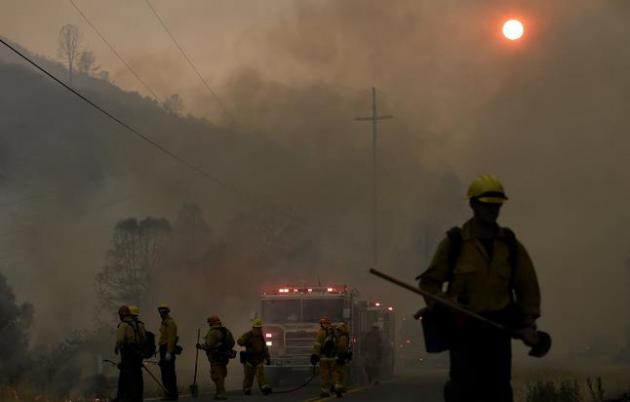


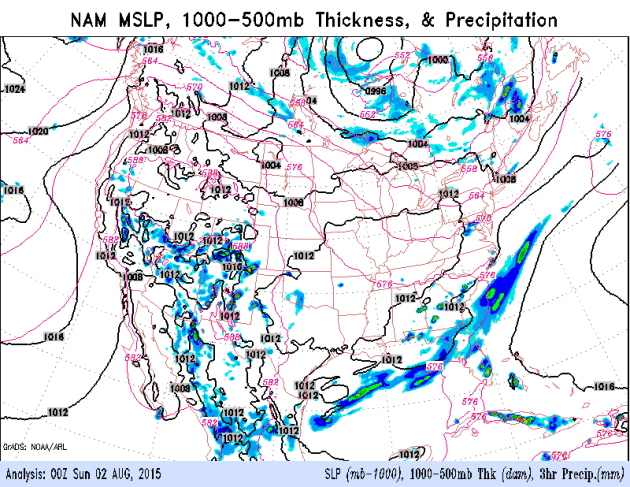


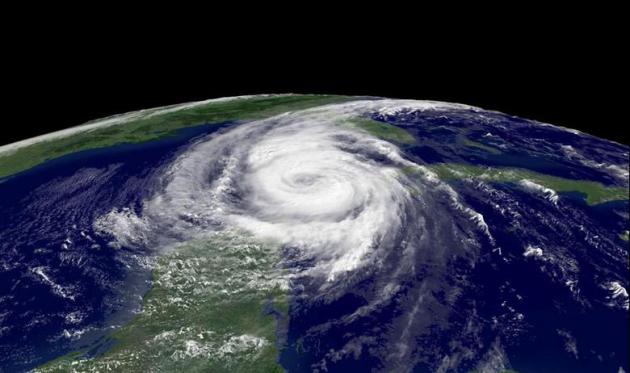




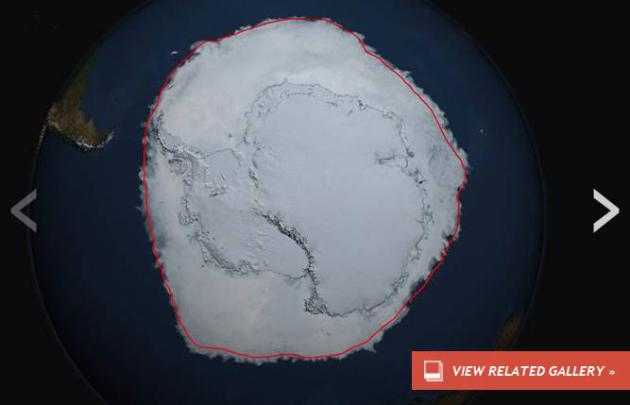



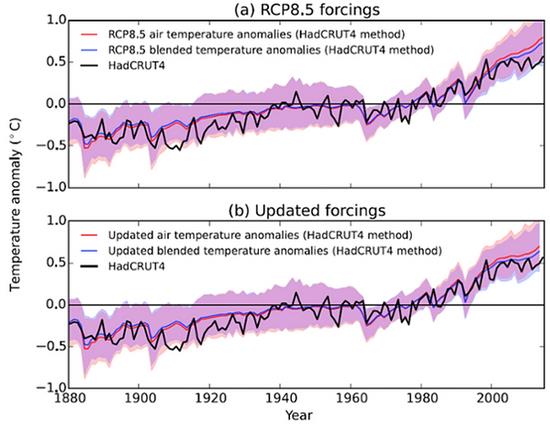
No comments:
Post a Comment